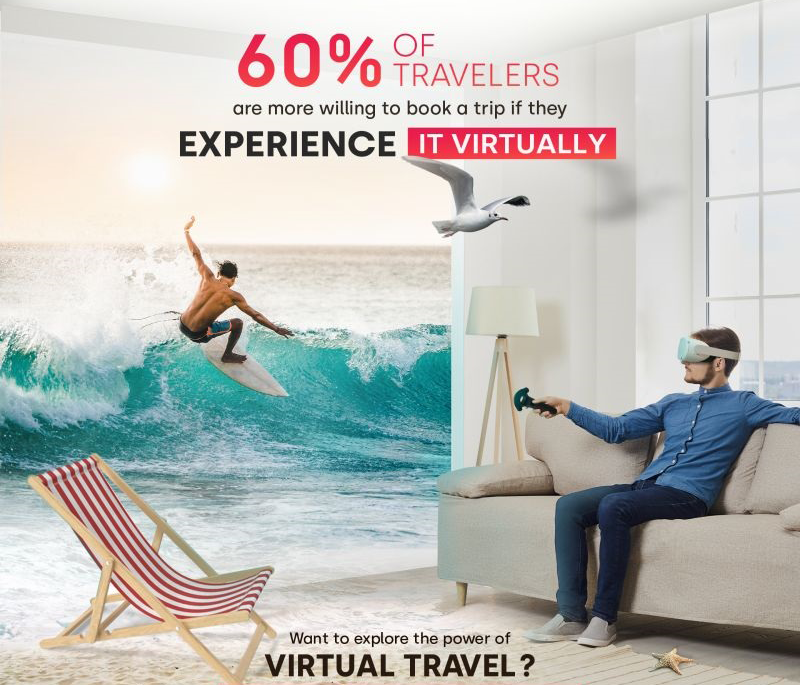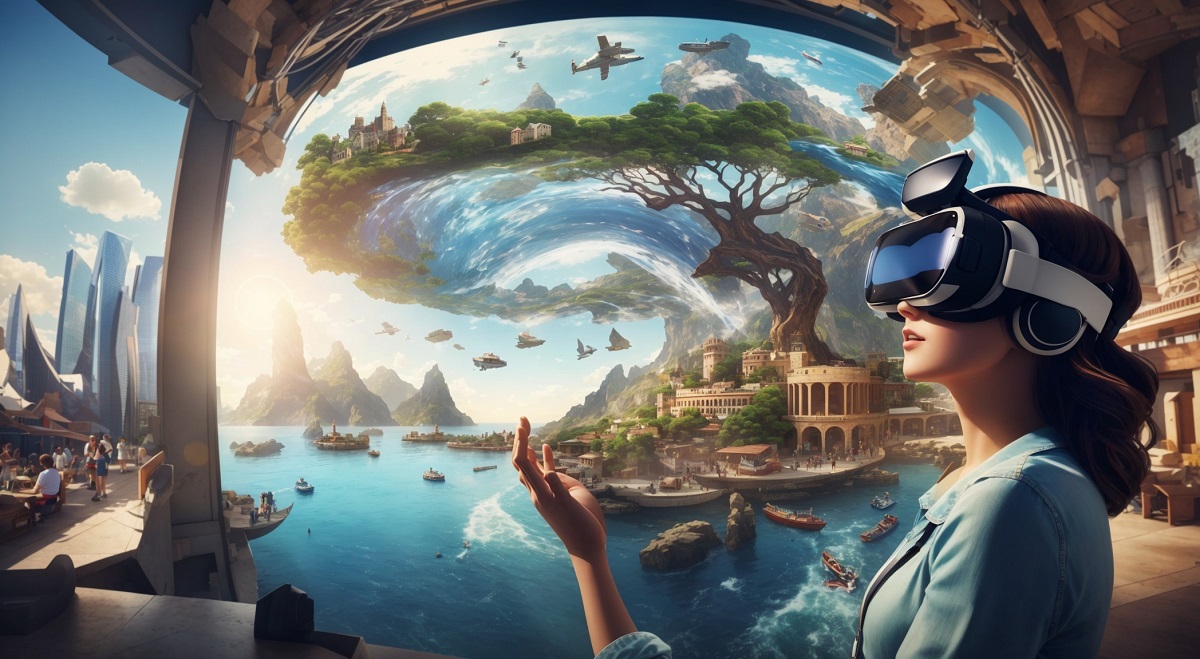Virtual Reality for Tourism Marketing Strategy
The tourism market has seen a staggering decline in recent years, especially in a world that’s recovering from the after-effects of a global pandemic. For instance, it was revealed that the number of international tourists dropped by over 70% after 2020.
And now, in 2024, the industry is facing a long and winding journey to recover itself to pre-pandemic levels – in a world that’s grappling with the war in Ukraine and still clambering out of travel restrictions.
Virtual reality for tourism marketing is one of the best examples in today’s digital landscape of how technology can prevent industries from stagnating, especially for travel and tourism, which is essential for many economies and a source of income for various countries.
Businesses to private and government bodies to even the local consumers and producers – all are involved in some way or the other in the tourism industry. And so, the impact of VR in the tourism industry is more tangible today than ever before.
What is Virtual Tourism?
Virtual tourism refers to the use of virtual reality solutions, such as headsets and scripted programs, among others, to enable traveling and tourism experiences.
It’s like having a window to the real deal for many travelers as it serves up iconic landmarks and vibrant cultures of popular destinations. Born from the pixels and lenses in front of your eyes, you can quickly redefine the way you travel or even plan to do so in the future.
For many seasoned travelers and even young amateurs, virtual reality for tourism marketing has helped people go beyond maps and brochures when looking for travel destinations. It has helped by giving them a glimpse or a taste of what a place on their list has to offer.
And though it’s too soon to begin answering the question: ‘Will virtual reality replace travel?’ What we do know is that VR has evolved to offer the thrill of exploration and various insights to people – guided by the magic of immersive technologies.
Benefits of VR in the Tourism Industry: Wandering Beyond Boundaries

The travel and tourism industry is a resilient one. Having suffered setbacks, it is now bouncing back with renewed vigor and with the world restoring itself to somewhat of its former semblance.
In such a phase, it is doubly vital to highlight the impact of virtual reality on tourism marketing and on the travel industry.
More companies and consumers including potential travelers are turning to virtual solutions. According to a study by the World Tourism Organization, VR is poised to increase the revenue seen by tourism by $1.5 trillion by 2030.
Here are some examples of how VR is being used for tourism and the benefits it brings to the industry:
✔️ Virtual Tours
Travelling through virtual programs and using immersive experiences is a much smoother and vibrant experience today owing to the advancements in VR technology. Virtual reality for tourism marketing has ensured that people can experiment and watch virtual tours, either as first-person clips or as live experiences.
- According to Sabre, more than 60% of travelers are more willing to book a trip and travel if they are able to experience it virtually.
This use case benefits tourism businesses and players by letting tourists visit virtual recreations of popular destinations as a sampler – without having to directly explore those spots physically.
✔️ Guided Sessions
More than just enabling people to watch locations and the local habitat virtually, virtual reality for tourism marketing enables companies and businesses to offer guided sessions.
This is important for travelers, especially for newcomers who might want a more guided experience after having arrived or before planning a trip.
For instance, the tourism board of Singapore offers travelers a VR experience that lets them see the city’s iconic places to visit. This virtual experience guides them through landmarks such as the Marina Bay Sands hotel or the Gardens by the Bay and other essential locations they might want to check out on their own.
✔️ Accessibility
Similar to the concept of AR restaurants which helps people in easily view the menu and food items, VR helps in addressing accessibility issues in tourism. It’s a boon for people who cannot travel freely while at a destination, owing to various reasons, or can’t make the trip at all.
For example, the tourism board of Iceland offers a VR experience for people who would like to go whale watching in the Arctic but can’t make it physically. They can experience it through the virtual program instead.
Plus, virtual tourism for marketing can bring immersive experiences in traveling for people who cannot travel due to mobility impairments or medical reasons.
In addition to these benefits offered by VR in the tourism industry, another fact that makes virtual reality so remarkable is the reduced impact of tourism on the environment.
This is an understated benefit, but a benefit nonetheless, as many environments and ecologies of travel destinations are fragile and may not support unfettered access to tourists. And companies or governments can actually adopt virtual reality for tourism marketing to address such challenges.
Exploring the Applications of Virtual Reality in Tourism Marketing

Virtual reality in the marketing sector has proven to be useful at various levels for different industries, and tourism is no stranger to its charm and possibilities.
It has a wide array of use cases, some of which are already being applied by industry leaders and top companies and governments in full swing.
With the global market for VR travel and tourism experiences poised to hit the $10 billion mark by 2024, let’s take a look at some of the crucial ways that VR helps in tourism marketing:
✔️ Hotel Previews
Virtual and planned walkthroughs may be created by hotels and motels to allow potential visitors to examine rooms, facilities, and vistas. This immersive experience can assist passengers in making more informed booking decisions.
It’ll be a familiar experience for those having experienced something like augmented hospitality, but on a much larger scale – enabling them to check out the place where they might stay while on vacation.
✔️ Historical Sites
VR may transfer users to historical times, allowing them to have personal experiences with the past. Virtual exhibitions and reenactments can be offered by museums and cultural institutions, providing informative and exciting experiences.
Similar to augmented reality, people would be able to view historical sites, places, and all it has to offer using VR headsets and solutions.
✔️ Explore Remotely
Virtual reality for tourism marketing can cater to and enable people to visit isolated or difficult-to-reach locations that might otherwise be inaccessible in reality. This broadens the options for vacationers looking for one-of-a-kind experiences.
And also alleviates the pressure on travelers who want to experience it all, while avoiding situations that don’t suit their schedule, adventure skills or physical capabilities.
✔️ Travel Planning
Virtual reality solutions may be used to help passengers plan their journeys. Points of interest, transit alternatives, and recommended routes may all be displayed on interactive VR maps, boosting the trip planning process.
It can help companies plan their campaigns even better, by personalizing tour packages as per what their customers prefer, thanks to virtual reality for tourism marketing.

Contact Us
✔️ Activity Training
Through the use of VR, tour operators may highlight adventurous activities such as zip-lining, scuba diving, and hiking. This can assist tourists in determining if specific activities are appropriate for their tastes and ability levels.
Furthermore, this will also enable the operators to train and educate about important things to notice during the activity, safety protocols, and more.
Decoding the Future of the Travel Industry with VR
Overall, VR in tourism is demonstrably important for the industry, as gathered from the benefits and important use cases we have seen. However, implementing virtual reality for tourism marketing requires one to focus on having high-quality, engaging, and user-friendly VR content.
So when you want a tourist to experience their first virtual stroll through cobblestone streets and grand views, they get fully immersed in the experience and adventure you’re advertising.
Bringing the charm of explorations and tours closer to innovation, our VR development company can transform how your travel experiences feel. At KOMPANIONS, we are skilled at working with unique VR experiences and the magical possibilities it brings forth into the real world from the digital.
So whether you’re a travel agency that wants to showcase a destination to your audiences or a hotel chain aiming to let your guests view their favorite place to stay, our expert team’s got your needs covered. Discover how the world of travel is changing – just one call away.







